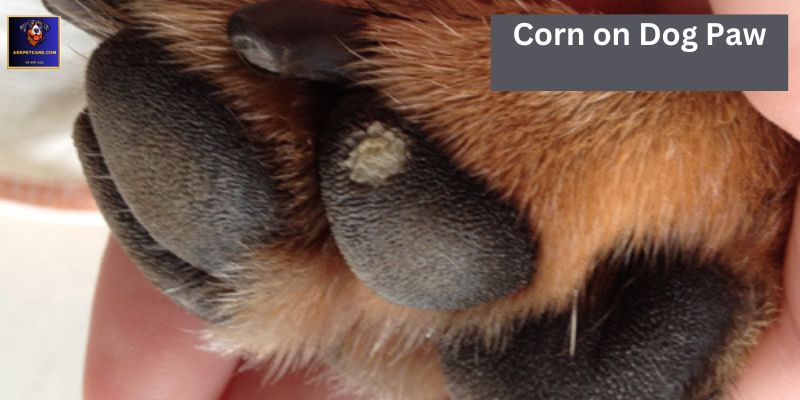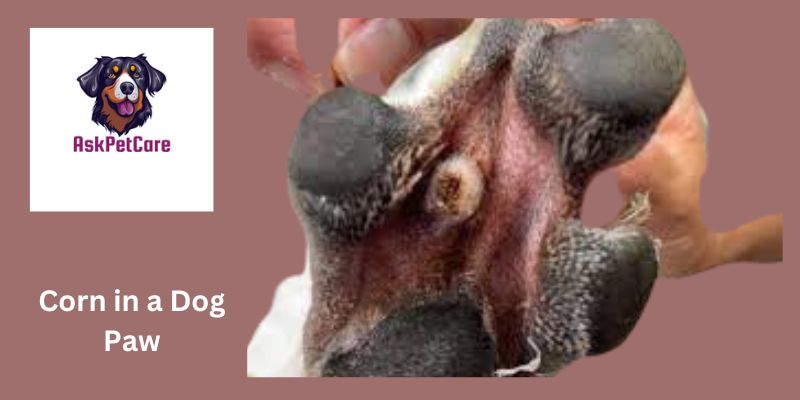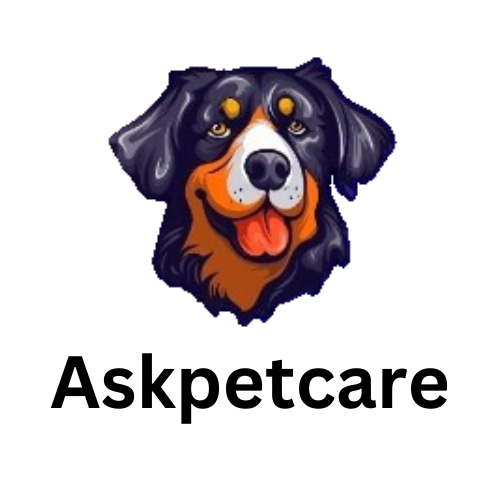Hello, dog lovers! I am Dr. Arif Aziz, and in this blog post, I will thoroughly explain what is corn in a dog paw. its reasons for development and how you can remove them.
Corns are hard, thickened areas of skin that can develop on a dog’s paws. They are caused by repeated pressure or friction on the skin and are often found on the pads of the feet or between the toes. Corns can be uncomfortable for dogs and may cause them to limp or avoid walking on the affected paw.
While writing this blog, I’m using what I’ve learned from my studies in veterinary medicine and running my pet clinic for 14 years. I’ve also gained knowledge from taking care of pets. The ideas I’m sharing come from knowing about animal health, pet care, and what’s best for our furry friends. Everything I’m saying is based on research, my experience working with animals, and my love for keeping pets healthy and happy.

Firstly we understand the structure of a corn-on-dog paw:
- Hardened Skin: Corns are composed of thickened and hardened skin tissue.
- Local Thickening: They typically form as a localized thickening of the skin in response to pressure or friction.
- Central Core: Corns often have a central core made of dead skin cells.
- Surrounded by Inflamed Tissue: The central core is surrounded by inflamed tissue, which can contribute to pain and discomfort.
- Size Variability: Corns can vary in size from small to larger, depending on the severity and duration of the pressure or friction.
- Common Locations: They commonly occur on weight-bearing areas of the feet, such as the toes, soles, or sides of the feet.
- Appearance: Corns may appear as raised bumps or circular discs of thickened skin. They can be yellowish, grayish, or even reddish.
- Sensitive to Pressure: Corns can be sensitive to pressure and touch, especially when direct pressure is applied to them.
- May Cause Discomfort: They often cause discomfort or pain, particularly when walking or wearing tight shoes.
- Underlying Causes: Corns are usually caused by repetitive friction or pressure on the skin over time, commonly due to ill-fitting footwear, abnormal foot anatomy, or certain activities.
Understanding the structure of corns can help in identifying and managing them effectively to alleviate discomfort and prevent recurrence
Corn in a Dog Paw

Several things can cause corn in a dog paw, including
Rough surfaces:
- Walking on rough surfaces, such as concrete or asphalt, can cause the skin on a dog’s paws to become irritated and thickened.
Ill-fitting shoes:
- Shoes that are too tight or too loose can rub against the skin and cause corns to develop.
Obesity:
- Obese dogs are more likely to develop corns because the extra weight puts pressure on the paws.
Certain medical conditions:
- Some medical conditions, such as hypothyroidism, can cause the skin to become dry and cracked, making it more susceptible to corns.
If you think there is corn in a dog paw, it’s important to take them to the vet for diagnosis and treatment. The vet may recommend some treatments, including:
Trimming the corn:
- The vet may trim the corn down to reduce the pressure on the skin.
Applying a bandage:
- A bandage can help protect the corn from further irritation.
Prescribing medication:
- In some cases, the vet may prescribe medication to help reduce the pain and inflammation associated with corns.
Preventing corns is the best way to keep your dog comfortable. Here are a few tips for preventing corn in a dog paw:

Keep your dog’s nails trimmed short.
- Long nails can put pressure on the paws and contribute to the development of corns.
Provide your dog with soft bedding.
- Soft bedding can help to reduce the pressure on your dog’s paws.
Avoid walking your dog on rough surfaces.
If you must walk your dog on rough surfaces, try to keep the walks short to prevent Corn in a Dog Paw
Choose shoes that fit your dog well.
- Shoes should be cozy but not too tight.
Monitor your dog’s weight.
- Obese dogs are more likely to develop corns.
By following these tips, you can help to keep your dog’s paws healthy and comfortable and remove corn in a dog paw.
8 corns in dog paw home remedy.
Having eight corns in a dog’s paw can be uncomfortable and painful for your furry friend. Corns are hard, thickened areas of skin that develop as a result of pressure or friction. It’s essential to address them on time to relieve your dog’s discomfort and prevent further complications. Here’s a home remedy to help lessen the discomfort caused by corn in a dog paw:
Here are some home remedies that may help treat dog corn:
Inspect the paw.
- Before you start any treatment, carefully examine your dog’s paw to confirm the presence of corns and to ensure there are no other injuries or foreign objects embedded in the paw pad.
Clean the Paw:
- Gently clean the affected paw with mild soap and warm water to remove any dirt, debris, or bacteria.
Soak the Paw:
- Prepare a warm water soak for your dog’s paw. You can add Epsom salts to the water to help soften the corn. Soak your dog’s paw in warm water for about 10–15 minutes to help soften the skin and reduce inflammation.
Apple cider vinegar:
- Applying apple cider vinegar to the corn can help to dry it out and reduce its size.
-

Corn in a Dog Paw
Tea tree oil:
- Tea tree oil has antibacterial and antifungal properties that can help fight the virus that causes dog corn.
Baking soda:
- Baking soda can help to absorb moisture and reduce inflammation.
Aloe Vera gel:
- Aloe vera gel has soothing and anti-inflammatory properties that can help relieve pain and discomfort.
Dietary Supplements:
- Omega-3 fatty acids and other supplements may help improve skin and paw health in dogs. Consult with your veterinarian about adding supplements to your dog’s diet to support paw pad health and reduce inflammation.
Cornstarch or baby powder:
- Cornstarch or baby powder can help keep the paw pads dry and reduce friction. Sprinkle a small amount of cornstarch or baby powder onto the affected paw, gently massaging it into the skin.
Trim the corns.
- After soaking, use a pair of clean, sharp scissors or nail clippers to carefully trim the excess skin around the corns. Be extremely cautious not to cut too deep or into healthy tissue, as this can cause bleeding and further discomfort to your dog.
Apply Moisturizer:
- Once you’ve trimmed the corn, apply a moisturizing ointment or cream to the affected paw. Look for products specifically formulated for dogs or those with natural ingredients like coconut oil or shea butter. Moisturizing the paw will help keep the skin hydrated and prevent further dryness and cracking.
Protect the Paw:
- To prevent further irritation and friction on the paw, consider using protective boots or socks designed for dogs. These can provide cushioning and support to the paw while allowing it to heal properly.
Monitor and repeat:
- Keep a close eye on your dog’s paw and monitor for any signs of infection or worsening of the corns. You may need to repeat the soaking and trimming process regularly until the corns heal completely.
Consult a veterinarian.
- If the corns persist or if you notice any signs of infection such as redness, swelling, or discharge, it’s crucial to seek veterinary care punctually.
Remember to always handle your dog’s paws gently and with care throughout the treatment process. Additionally, maintaining a clean and comfortable environment for your dog, along with regular nail trimming and paw care, can help prevent the recurrence of corns in the future.
It is important to note that these home remedies are not a substitute for veterinary care. If your dog’s corn is severe or does not improve with home treatment, you should take your pet to the vet to remove Corn in a Dog Paw
What dog breeds get corn?
Corns, also known as hyperkeratosis, can affect dogs of any breed, but some breeds may be more susceptible to developing them due to various factors such as genetics, anatomy, and lifestyle. Here are some dog breeds that are commonly associated with corn:
Greyhounds:
Greyhounds are frequently susceptible to developing corns due to their unique anatomy and thin skin. The pressure placed on their paw pads during racing and exercise can contribute to the formation of corns.

Labrador Retrievers:
Labrador Retrievers are active and energetic dogs that are often engaged in various outdoor activities and sports. Their active lifestyle can lead to increased friction and pressure on their paw pads, making them more susceptible to developing corns.
Boxers:
Boxers have relatively short coats and are known for their high energy levels. Their active nature and propensity for running and playing on rough surfaces can result in the development of corn on their paw pads.
Bulldogs:
Bulldogs have unique foot structures with compact, tightly knit toes. This conformation can predispose them to corn, especially if they are overweight or engage in activities that put stress on their paw pads.
Greyhound Mixes:
Dogs that are mixed with Greyhound genetics may also inherit the predisposition to develop corns due to their shared ancestry with purebred Greyhounds.
Large and Working Breeds:
Large breeds such as Mastiffs and Great Danes and working breeds like German Shepherds may be susceptible to corn due to their size and the demands of their activities, which can include running, hiking, and working in various environments.
Corns typically develop on weight-bearing areas of the paw pads where there is repeated pressure and friction. They appear as hard, circular areas of thickened skin that can be painful and uncomfortable for the dog.
Preventing corn in a dog paw involves maintaining proper paw pad hygiene, keeping nails trimmed, providing appropriate cushioning during exercise and play, and avoiding abrasive surfaces. Regular inspection of the paw pads can help detect corn early, allowing for prompt treatment and management.
If a dog develops corns, treatment options may include soaking the paws, trimming the excess keratin, applying moisturizers, and using protective boots to reduce friction and pressure. In severe cases or if the corn in a dog paw becomes infected, veterinary intervention may be necessary to provide appropriate care and alleviate discomfort.
While certain breeds may be more prone to developing corns, proactive paw pad care and attentive management can help minimize the risk and ensure the comfort and well-being of the dog.
If you want to learn about dog foot and paw allergies, then click on it.
- “The Complete Dog Owner’s Manual” by Dr. Bruce Fogle
- “The Ultimate Guide to Dog Care: Everything You Need to Know to Keep Your Dog Happy and Healthy” by Amy Marder and Andrew Luescher
- “The Veterinarians’ Guide to Natural Remedies for Dogs: Safe and Effective Alternative Treatments and Healing Techniques from the Nations Top by Martin ZuckerTop of Form

2 thoughts on “What is Corn in a Dog Paw? Dr practical assessment.”